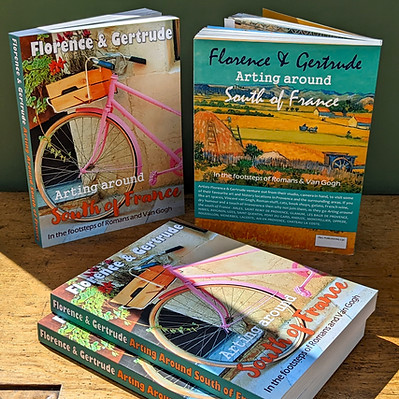FLORENCE & GERTRUDE
BOOKS
Published and forthcoming titles from Florence & Gertrude Editions.
THE VERTICAL LINE : Observation and Abstraction in Contemporary Painting
Harry MC www.harrymc.co.uk
Publishing: January 2026
Format: A5 · 136 pages
Description
The Vertical Line is a sustained investigation into stripe painting as a method rather than a style. Drawing on five decades of observation and studio practice, Harry MC examines how vertical division can carry light, colour, and rhythm without recourse to image or narrative. Grounded in long-term observation in Provence and resolved in a Bath studio, the book traces how architectural structure and Mediterranean light can be translated into measured sequences of paint. This is not a history of stripes, nor a manifesto. It is a practical account of how a reduced visual language remains unexhausted — how proportion, temperature, and interval continue to generate new problems when taken seriously over time. Written with clarity and restraint, The Vertical Line offers insight into abstraction as lived practice: slow, cumulative, and accountable to looking.
Publisher: Florence & Gertrude Editions

THE VERTICAL LINE
Observation and Abstraction in Contemporary Painting
ARTING AROUND SOUTH OF FRANCE
Florence & Gertrude ( text & photography)
Published: 2024
Format: 20cm x 26cm - 252 pages
Description
Arting Around South of France is a visually led travel book built from repeated trips through Provence and the surrounding region, written and photographed by Florence & Gertrude. Moving between art spaces, historical sites, and the everyday life of towns, it maps a practical, personal route for travellers who like to look — and to return.
The book brings together museum and foundation visits, Van Gogh locations, Roman architecture, bookshops and street scenes, with a light touch and an eye for detail. Locations include Arles, Saint-Rémy-de-Provence, Glanum, Les Baux-de-Provence, Nîmes, Avignon, Uzès, Pont du Gard, Anduze, Montpellier, Oppède, Roussillon, Ménerbes, Lacoste, Aix-en-Provence and Château La Coste.
Publisher: Florence & Gertrude Editions


FERMÉ LE LUNDI
Art Spaces in the South of France
Florence & Gertrude (text & photography)
Publishing: 2026 (month tbc)
Format: A4 · 192 pages
Description
Fermé le lundi — “closed on Mondays” — began as a familiar frustration: you arrive at a much-anticipated art museum or foundation and find the doors shut. Rather than fight it, this book leans into the rhythm. It’s a visually led guide to contemporary art spaces across the south of France, built from first-hand visits, repeat trips, and the kind of planning that always includes a back-up.
Made for anyone who loves the feel of contemporary art spaces — the calm, the light, the scale, the particular hush of a good room — it brings together photographs with concise notes on museums, foundations and artist sites worth the detour. Practical enough to travel with, but paced like an art book, it’s designed for returning to as much as arriving.
Selected locations include LUMA Arles, Fondation Maeght, Fondation Carmignac, La Friche la Belle de Mai, Collection Lambert Avignon, Carré d’Art Nîmes, Fondation Vincent van Gogh Arles, Lee Ufan Arles, La Ribaute (Kiefer) and Fondation Vasarely. Tuesdays are strongly recommended.
Publisher: Florence & Gertrude Editions

FERMÉ LE LUNDI
Art Spaces in the South of France